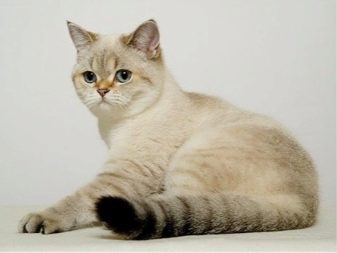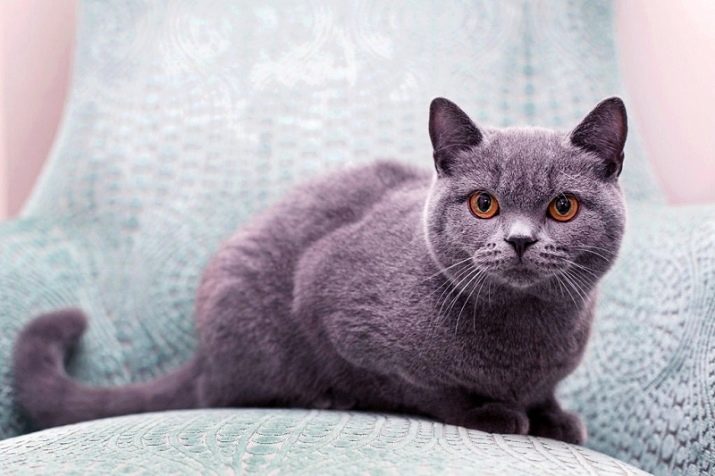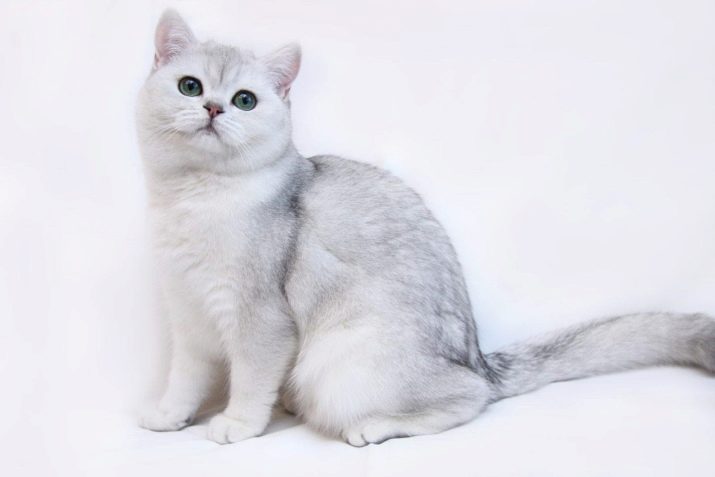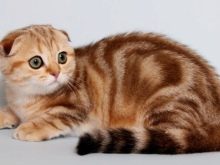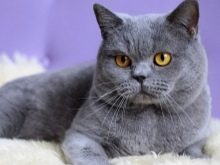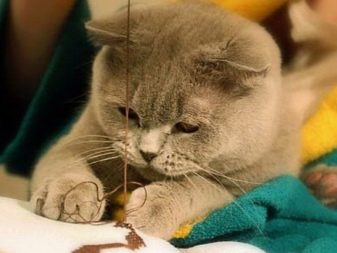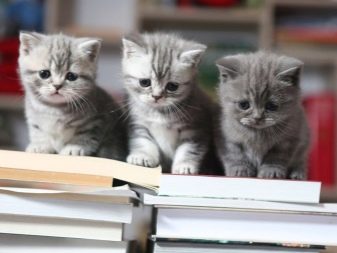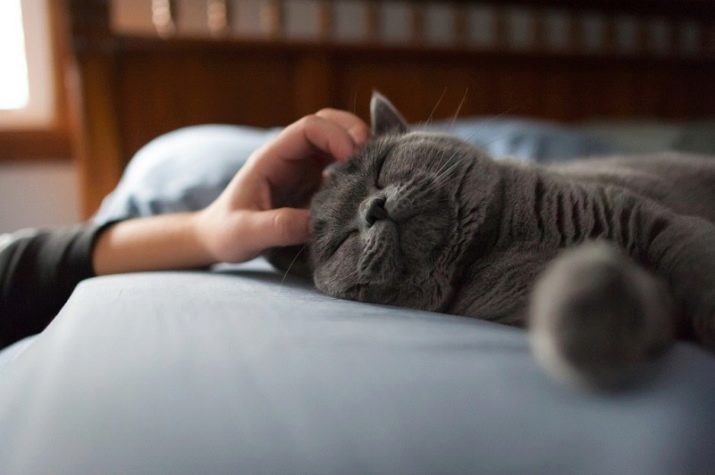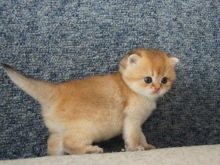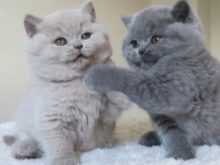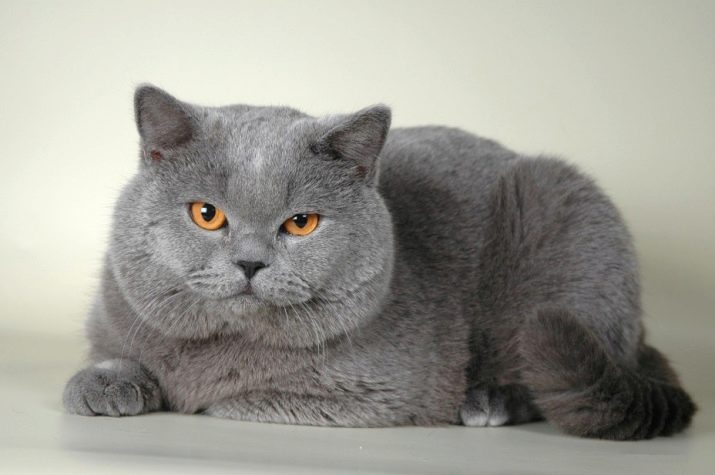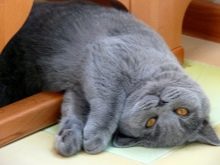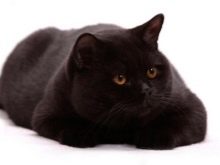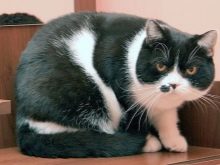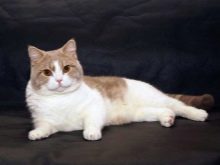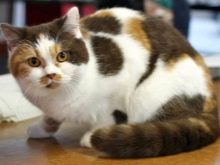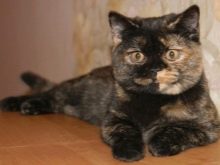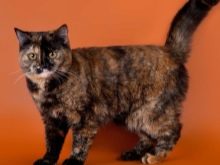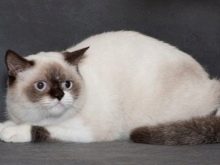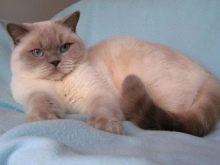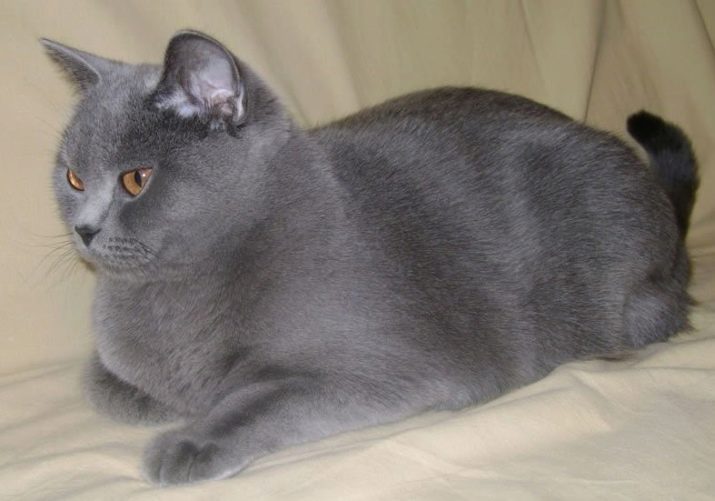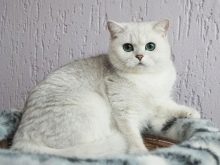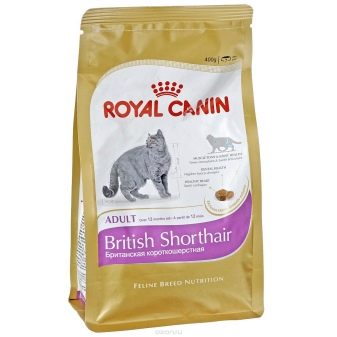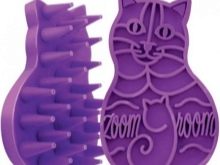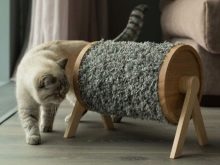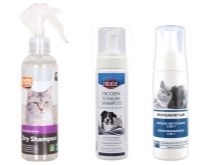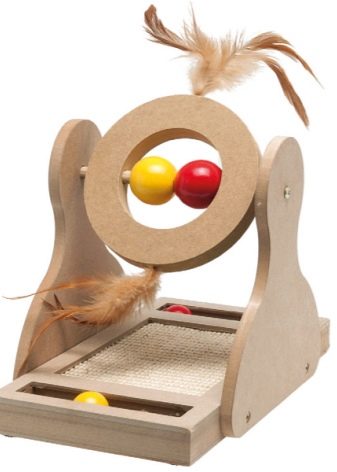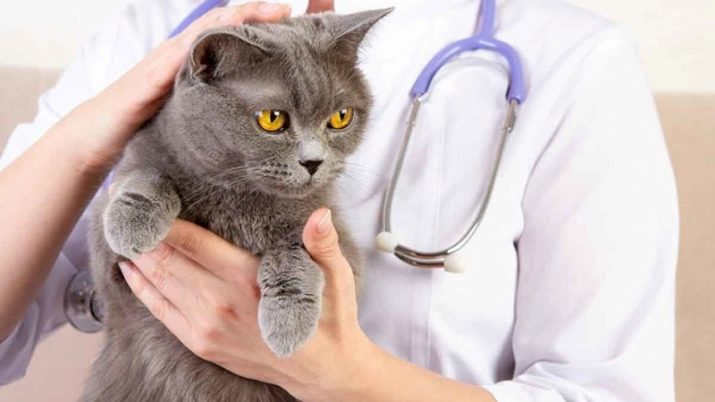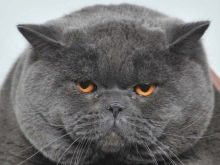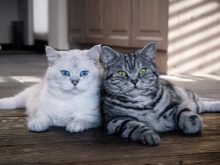British Shorthair cats: breed features, color variations and rules of keeping

The domestic cat is the favorite animal of billions of people, in some cultures it was even revered as a symbol of some local deity. At the same time, in each region “local” cats look differently, which depends on the characteristics of the wild species, which was domesticated here, and on the climatic conditions, and on a certain natural selection, and nowadays even on selection. The British Shorthair cat is considered one of the most recognizable - it is a royal individual with a well-marked aristocratic appearance.
History of origin
Contrary to the direct reference to Britain, the ancestors of this breed came to the islands from the outside - scientists even know an approximate answer to the questions about when and how this happened. For two thousand years, modern England was a colony of the Roman Empire, and in the metropolis at that time cats were very much appreciated as useful hunters with excellent physical characteristics and the ability to get used to any conditions.
In the south of Europe, where Rome is located, thick fur was not needed by such animals, because they were smooth-haired.
It is difficult to say whether local domesticated cats were in Britain at that time, but the Romans who lived here preferred to take pets from the south - by that time they had relatively formed into an attractive breed.
At the same time, in these small animals, first of all, not only appearance, but the outstanding hunter's instinct was most valued. It is proved that the ancestors of the modern "British" for centuries lived not in houses, but in the streets and in barns, where they fulfilled the purpose for which they were domesticated - they drove mice and rats. At the same time, the popularization of the breed as something aesthetically beautiful began only in the 19th century thanks to Harrison Weir, who loved these Fuzzies very much and specially selected the kittens for breeding work for many years.
By his efforts, the local baleen four-legged, previously regarded as a purely working class, came to the cat show in the London Crystal Palace, after which people looked at them from a different angle.
In 1871, they even released the Standard of the breed, after which these animals began to be massively raised for sale.
Despite the great popularity of the breed, after World War II it almost disappeared - during the war years there was simply no one to engage in professional breeding of purebred animals. Because of this, it was decided to allow the remaining representatives of the breed to cross with Persian cats and chartreuse. Because of this, the modern British Shorthairs are somewhat different from the classical idea of them - today they stand out for calmness, as well as a larger head with a rounded muzzle, although before all these features were not inherent to them.
Description
Basic information about this breed is probably known to every avid cat lover, however, for an inexperienced person, the information below may be useful.
The British Shorthair belong to rather large animals, for an adult male the normal weight is 4-8 kg, and for the female 3-5.5 kg.
At the same time, a castrated animal can be fattened even up to 12 kilos, whereas a cat usually does not get heavier than 7 kilograms. Such animals become mature at about 3-5 years old.
The large size of such cats are not expressed at a considerable height - they are just considered to be short, they simply differ in roundness of forms and generally resemble a densely stuffed plush toy. The similarity is further enhanced by the very soft and thick coat of wool, which, indeed, resembles plush. The coat is so soft and docile that even when stroking the coat against the coat, it does not ruffle, as it usually is, but as if it is combed in the opposite direction.
In most cases, modern British Shorthair cats have a bluish color - the presence of Persian and French impurities, which had to be resorted after the Second World War, affects.
In this case, the color may be some other - for example, there are also completely black individuals, and blue-gray, and even purple.
The two-color color is very popular, especially if it is combined in a smoky or tortoise pattern.
It is not too true to attribute human facial expressions to an animal, but on the whole it looks like it always smiles - at least there is practically no “dissatisfied” expression of a cat's face. In combination with a calm character and a typical “plush” appearance, this makes representatives of the breed a very popular pet because of its “positive”.
Character traits
A characteristic feature of the representatives of this breed is that they are calm and balanced. Such an animal is completely calm, while it is devoid of aggression typical of a predator and usually does not resist the will of man.
Moreover, such a “plush” cat differs not only in its stunning appearance, but also behaves accordingly. Unlike many other cats, this breed is able to bind to the owner or to family members whom the four-legged pet trusts.
Such a cat has a tender character, it treats children's pranks with understanding and does not respond to them with aggression. The "British" are good because they have no "favorites" in the host family - they are exactly the same for all households.
Shorthair cats from England like to accompany their landlord around the apartment, they usually choose the same room as the person for their time being. They are not against the manifestations of affection on the part of the owners, but at the same time they are not too annoying - in particular, they do not ask for their hands and, in general, do not like to go there. Such an animal is not deprived of a certain degree of its own independence, it will understand if you do not have time for it, and will not suffer from it.
Such a cat does not need to constantly entertain - it normally perceives the everydayness of life and does not seek special adventures.
Shorthair "British" is often chosen by those people who generally love animals and do not want to be limited to just cats. The fact is that, due to its innate tranquility, this breed normally reacts to most other types of animals, therefore it does not provoke conflicts with dogs, and also does not seek to attack rabbits or poultry.
Outsiders "British" do not confuse, she realizes that it is they who are her guests, and not vice versa. The animal will behave in their presence as usual.
It is striking that a cat does not treat all guests equally - it is cold to someone, but more gracious to others.
At the same time open hostility on her part definitely will not be in any case.
Short-haired cats are not very similar to the rest of their relatives in the sense that they do not have the typical feline flexibility - such a "plush toy" is relatively clumsy. A small physical deficiency of an animal with a developed intelligence and excellent memory - for example, an individual who once managed to open the door on his own will understand the value of such a skill and will remember the entire sequence of actions, later repeatedly resorting to the knowledge gained as needed. Accordingly, such a four-footed dog lends itself well to training, it can be quickly accustomed to the tray.
“British” youths are notable for their playful disposition, they will be happy to get involved in the game proposed by the host, but this is characteristic only for a certain age.
The one-year-old animal differs in a far more serious attitude to life, it is not looking for adventure and prefers to stay at home.
Restrained habits are even that the cat does not seek to spoil the furniture, and in general behaves like a real English aristocrat.
This breed will not interfere with the neighbors from below, not only with the stamping of paws, but also meowing - these animals rarely resort to it, they draw attention to themselves only if they need something from humans. At the same time, their meowing is relatively quiet, because it is convenient to keep such a calm and balanced predator even in a high-rise building.
Lifespan
On average, British Shorthair cats live around 14-16 years old, provided that all the necessary conditions are created for them, and the animal is not lacking in anything. In this case, there are cases where individual instances lived even up to 20 years old, so a similar pet is serious and for a long time.
At the same time, one should not believe the popular opinion that one feline year is supposedly equal to seven human ones.
Felinologists, that is, experts on these animals, say that The one year old British Shorthair cat is developed at about the same level as a man in her 15 years. By the age of seven cats, the animal reaches the level of a 45-year-old man, and from that moment the cat begins to age. If it is possible to make the beast live to be 20 years old, then it will be decrepit at the level of a typical 95-year-old man.
At the same time, the majority of owners still want their pet to become a real long-lived feline; therefore, over the years of breeding, certain criteria have been developed for the conditions under which the animal must live as long as possible. Of course, we need normal conditions of detention, which will be discussed below in a separate section. In this case, the innate calm of the cat should not be disturbed by stress and excessive exercise.
The breed is characterized by a reduced number of diseases of genetic origin and increased resistance to oncological diseases.
Sterilization and castration usually prolong life slightly, but representatives of this breed should not be overly protective - let the animal live as it wants, and it will appreciate it.
Coat color options
Contrary to the fact that most of the breeds have very specific characteristics regarding external data, the short-haired “British” do not have strict requirements for a specific color - the fact that they were mixed with other breeds has an effect.
There is a registry, which includes as many as two hundred coloring options, recognized as "normal" for this breed.
At the same time, the overwhelming majority of the population is blue, but it is worth highlighting some other colors that are in great demand. For inexperienced cat owners, some terms in the description of the animal may be incomprehensible, therefore we will consider at least the main thing.
- Solid, or solid color, It implies not just one tone for all tips of the coat, but also a uniform coloring of the entire length of the hairs together with the undercoat in one shade. Usually these are blue, marble and silver gray, black, and also brown and red cats.
- Bicolor - a combination of two colors, one of which is white.
- Turtle They call it a tricolor color, while the colors included in the palette need not be fundamentally different, but at least a clear distinction between similar shades should be visible.
- Colourpoint - This is an imitation of the color of Siamese cats. Such animals are almost always distinguished by their characteristic blue eyes, although for British Shorthair cats, eye color is considered the norm to match the basic color.
- Smoke color assumes that the wool in the root half is colored white, while the visible part is different and forms the “main” tone of the animal.
- Chinchilla color it resembles a smoky principle, but here only the tips of the hairs are colored basic, while the entire undercoat is white.
- Tabby - A term describing a large number of varieties of colors, when, with the main gold or silver shade, the animal is decorated with any complex pattern from striped to more sophisticated.
Feeding
The aristocracy of this breed does not allow to feed such an animal with anything.
In fact, the owner is obliged to monitor the diet of his ward, not only to give him only the best and most useful, but also to not allow him to eat everything in unlimited quantities.
The fact is that the measured lifestyle of this slightly lazy predator greatly increases the likelihood of obesity of an animal, and this, as we know, adversely affects the general health of the pet. For this reason, it is unacceptable to overfeed a pet, and it is undesirable to feed it with “human” food, especially fatty, floury, or sweets.
Most of the owners of these aristocratic cats prefer not to engage in self-preparation of the diet, and trust the producers of pet food. For the “British”, both dry (with plenty of drinking water) and soft mixes will be a good solution, and they often say that they need premium quality class.
Mixing different brands of feed between them is undesirable, just as you shouldn’t make a mix of supposedly the same feed from different companies.
Taking care of consumers, manufacturers usually indicate on the box how much food an animal needs per day - it helps to calculate the number of boxes before the next visit to the store, and not to overfeed the four-legged friend. At the same time, babies younger than six months are usually fed three times a day, whereas adult individuals undergo a similar pleasant procedure only twice. At the same time, other sources insist that babies should be fed 4-5 times a day, and adults - three times, but the daily rate of this in any case does not change.
Some owners of British Shorthair cats do not trust the feed producers too much and prefer to independently form the ration of pets from “understandable” products that can be eaten by the person.
This approach is valid if you know what products will be useful for the animal and will not harm its health.
The daily need of a pet is about 70 calories per kilogram of weight, on the basis of which the calculation of the quantity of products is done. Important ingredients in this menu are cereals, vegetables, dairy products and, of course, meat. The role of the latter is best suited to low-fat beef, which, for the sake of the convenience of a non-bloodthirsty animal, is better to cut into small pieces beforehand. Alternatively, you can also give a bird, and once or twice a week - boiled sea fish.
It is important to remember that fermented milk products give a pet once or twice a week, but it should not be fresh milk, because it often provokes violations of the gastrointestinal tract.
Boiled egg yolk in the cat's diet is allowed, but they should not be too carried away too - it is also given only 1-2 times a week.
If feeding is still on schedule, the animal may want to drink at any time, because access to clean and fresh water he should be constantly. This is especially important if the basis of the diet consists of dry food, otherwise discomfort to the cat is provided.
Conditions of detention
British shorthair cats, in spite of their aristocratic appearance and the same habits, are not particularly whimsical in caring, because it is quite simple to care for them.At the same time, completely ignoring the care of an animal is not worth it, otherwise it may lose its trademark plush appeal or even become ill.
Despite the fact that the “British” belong to short-haired breeds, the main thing is the care of hair - so that it does not accumulate throughout the apartment, the animal should be regularly combed.
During the molting period, this will have to be done daily, but at all other times it will be sufficient to conduct the procedure on a weekly basis. To complete the task, you should equip it with a special rubber-toothed brush, which is sold in any pet store. Scrub this cat cautious movements, first against the coat, and then vice versa. The peace-loving animal not only does not resist such events, but usually perceives them very favorably and even with some joy.
It is necessary to wipe the ears of the animal weekly, which will also be perceived rather calmly.
Teeth brushing will cause a brighter negative reaction, which should be done not just weekly, but at least once during this period, then as often as possible. If you ignore this need, the animal may face diseases of the oral cavity, and treatment will be more difficult and costly than prevention. An alternative solution may be special food special consistency, which provides a cleansing effect - at least, do not have to torment the animal unpleasant procedures.
Claws interfere with the animal, but they need to be cut as needed - on average, the need for such a procedure occurs every 2-3 weeks. At the same time, the cat itself can partially solve this problem, if a scraper has been bought specifically for it - though, because of the calm temper, these four-legged people may be interested in it to the same extent as the furniture, that is, simply ignore it.
It is usually not necessary to bathe an animal - it is rather clean and diligently takes care of itself.
Water procedures threaten such a cat only if the pet is somewhere very dirty from contaminating contaminants, in all other cases, the minimum purity can be maintained with a dry shampoo.
Not that the British Shorthair cat was too afraid of unusual conditions, but for her good health and longevity, it is desirable to make sure that the living conditions in the house are comfortable.
The beast loves neither cold nor excessive heat, and too dry and too humid air is unpleasant for him. The room in which the cat lives must be regularly ventilated.
Although the “British” are distinguished by calmness and aristocratic mores, they sometimes also need to frolic, if only to maintain their normal physical form. You should not force a pet if he clearly does not want to play, but in general, he must provide such an opportunity. To do this, make sure that the cat has space for games. And also do not regret money for interesting toys and time - for spending time together with your pet.
Sitting all day in four walls, the short-haired beast can receive less of any vitamins or minerals that it would find in the wild. For pets, special vitamin-mineral complexes are produced, which must be included in the daily diet in the recommended amounts.
Health
Among all their relatives, the British Shorthair cats stand out in good health - we have already said above that neither cancer diseases, nor many other typical feline diseases "take" them.
Of the serious diseases of this breed, it is possible that polycystic and hypertrophic cardiomyopathy may threaten, but they are rarely diagnosed and in most cases do not concern the pet. However, this does not mean that you should not worry about the health of your four-legged friend.
Firstly you need to periodically visit the vet for routine checkups. As in the case of a person, any disease identified at an early stage of development can be cured with less time, money and effort. In addition, in a veterinary clinic, you can get a vaccination, thanks to which the animal will get an immunity to many potential diseases in advance - then you can not worry about their occurrence at all.
Despite the fact that the animal mostly lives at home, feeding only on what the owners give it, a certain risk of the appearance of helminths in its organism still remains. The solution to this problem is timely deworming, for which you will also have to contact a veterinarian.
A certain problem, which was already mentioned above, is the tendency of representatives of this breed to obesity, which, in turn, can provoke many more serious problems. Castrated and sterilized individuals, whose body no longer spends energy to maintain the basic instinct, gain weight even faster, and therefore are at increased risk.
Such animals are even less mobile than their “usual” relatives, therefore owners should be even more careful in monitoring the quantity and quality of food eaten by the pet.
Contrary to the fact that the British Shorthair cats do not like excessive activity and often perceive it as extra stress, such individuals should be specially involved in games and interested in toys, because with a sedentary lifestyle, even a balanced diet can provoke weight gain.
At the same time, the observance of simple rules of care and the creation of proper conditions for a pet to live allows to avoid the development of most diseases and significantly prolongs the pet's longevity.
For general information about British Shorthair cats, see below.

